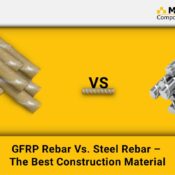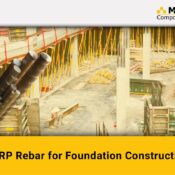What is Rebar? Types Of Rebar
Rebar—short for reinforcement bar— is a fundamental material in construction industry. Rebar plays a vital role in construction, it makes the construction stronger so it can withstand harsh conditions.
Contractors or engineers can use bars in following construction applications such as
- Bridge construction,
- Road construction,
- Industrial Foundation and base slab,
- septic tank,
- Swimming Pool construction,
- underground water tank and many more.
This article explores what is Rebar?, its types, the advantages of GFRP rebar, applications, and a comparison of GFRP rebar vs. steel rebar.
What is Rebar?
Rebar is a composite bar that is embedded in concrete. It increases the strength of construction. Concrete is strong in compression but unable to handle more tension, bar compensates this weakness and makes construction more stronger.
Manufacturers produce bars with ridges, lugs, or deformations on its surface. These deformations help the bar bond securely with the concrete, preventing slippage and ensuring the integrity of the structure. Rebar is critical in the construction of buildings, bridges, highways, dams, and many other infrastructure projects.
The Importance of Rebar in Construction
In the construction industry, Strength, Durability, lightweightness, cost-effective construction material are paramount.
- Resist tension and bending forces
- Distribute loads evenly
- Withstand environmental factors such as temperature changes and moisture
- Maintain structural integrity over time
Without bars, Construction can crack and weaken. By incorporating rebar, the construction can stand resolute.
Types of Rebar
In the construction industry, there are many types of bars available in the market. Let’s explore the most common types:
1. What is GFRP Rebar?
GFRP (Glass Fiber Reinforced Polymer) Bars are a modern construction material. It is an alternative to steel . GFRP is stronger, lighter, cost-effective and durable construction material. GFRP composites of Glass Fibre and Reinforced Polymer. Glass fibre protects the polymer rebar. Contractors and Engineers use GFRP at bridge construction, roads, highways, base slab, industrial floor, foundation and many more.
2. Steel Bars
Steel is a traditional construction material. Steel has some disadvantages such as weight, strength, and corrosion. Steel is not compatible with water. By using steel , it can weaken the construction and sometimes it also requires regular maintenance.
3. CFRP Rebar
CFRP (Carbon Fiber Reinforced Polymer) is made from carbon fibers embedded in a polymer matrix. It offerece strength and corrosion resistance. Contractors can use CFRP in various applications in the construction industry.
4. TMT Bars
TMT (Thermo Mechanically Treated) Bars are a type of steel reinforcement bar. TMT bars are produced through a control heat treatment process.
5. RCC
RCC (Reinforced Cement Concrete) is not a type of bar but rather a construction method that combines concrete and bars. The bars (usually steel) reinforces the concrete, creating a composite material that’s strong in both compression and tension. RCC is widely used in construction for its strength and versatility.
Advantages of GFRP Rebar
GFRP is transforming the construction industry thanks to its unique properties. Here are the key advantages of using GFRP:
- Corrosion Resistance: GFRP does not rust or corrode. GFRP is compatible with water, salt water and other chemicals. Engineers can use GFRP in marine structures.
- Lightweight: GFRP is ¼ lighter than traditional steel reinforcement bars.
- High Tensile Strength: GFRP is two times stronger than traditional steel.
- Non-Conductive: Because GFRP does not conduct electricity, it’s perfect for use near electrical installations, MRI rooms, and other sensitive areas.
- Cost-Effective: GFRP is a durable material. By using GFRP, construction does not require regular maintenance and replacement.
- Durable: GFRP is corrosion resistant, stronger, lighter, and non-conductive construction material. GFRP increases the life span of construction.
Applications of GFRP bars
Engineers can use GFRP bars at various construction applications.
- GFRP Rebar For Bridge Construction: GFRP is stronger and lighter material. It provides more strength at lighter weight in bridge construction.
- GFRP Rebar For Marine Structures: GFRP is Perfect for seawalls, piers, docks, and construction near water due to its corrosion resistance.
- Retaining Walls: Provides long-lasting reinforcement in structures exposed to moisture and aggressive chemicals.
- GFRP Rebar For Underground Construction: GFRP Withstands harsh underground conditions. It is an ideal choice for underground construction.
- GFRP rebar For Industrial Flooring: Enhances the strength and longevity of industrial floors subject to heavy loads and chemicals.
GFRP Rebar vs. Steel Rebar
Corrosion Resistance
- GFRP: GFRP is corrosion resistant construction material. It does not rust and corrode. It is compatible with water, chemicals and salt water.
- Steel: Steel bars are prone to corrosion over time, especially in marine or chemical-rich environments. It weakens the construction and requires regular maintenance.
Weight
- GFRP: GFRP bars are ¼ lighter than traditional steel bars. Manufacturing and transportation cost is low for GFRP.
- Steel: Heavy, which can make transportation and installation more challenging and labor-intensive.
Tensile Strength
- GFRP bars: GFRP is two times stronger than traditional steel. It makes the construction stronger.
- Steel bars: Has lower tensile strength compared to GFRP, potentially requiring more bars to achieve the same load capacity.
Electrical Conductivity
- GFRP: Non-conductive, which eliminates issues related to electromagnetic interference and makes it safer in electrical-sensitive applications.
- Steel: Conductive, which can lead to problems with electrical interference and may pose risks in certain installations.
Maintenance
- GFRP: GFRP is a durable construction material. By using GFRP construction does not require regular maintenance and replacement.
- Steel bars: By using Steel, construction will require regular maintenance and replacement. It increases the cost.
Lifecycle Cost
- GFRP bars: GFRP bars are durable construction material. It saves the maintenance cost, transportation cost.
- Steel bars: Steel bars are not durable construction material. It requires regular maintenance and replacement so it increases the costs.
GFRP bars is a modern construction material, It is an alternative of steel bars. Here you can check for GFRP Rebar vs. Steel Rebar.
Conclusion
Bars are the backbone of concrete construction, providing strength, stability, and durability. Understanding the different types of bars and their applications is essential for selecting the right material for your project.
While steel bars remain popular, GFRP Bars stands out for its corrosion resistance, lightweight, and high tensile strength. By choosing GFRP, construction professionals can build structures that last longer, require less maintenance, and deliver better performance over time.
MRG Composites
MRG Composites is the leading GFRP rebar manufacturer in India, offering high-quality and durable solutions for construction projects. As The Pioneers of GFRP rebars in India, MRG Composites sets the benchmark for innovation and reliability. With the best GFRP rebar prices in India, we ensure quality and reliability. Contact us for expert consultation and superior reinforcement solutions. GFRP Rebar is an ideal choice for all construction.
- What is the HSN Code for GFRP Rebar?
The HSN Code for GFRP Rebar is 701990.
- Why Choose GFRP Rebar?
It’s corrosion-resistant, lightweight, strong, non-conductive, and reduces maintenance costs
All Categories
Recent Posts
GFRP Rebar vs. Steel Rebar: Strength, Durability & Benefits
GFRP Rebar for Foundation Construction
MON-SAT 8:00-9:00
+91 69 863 6420




